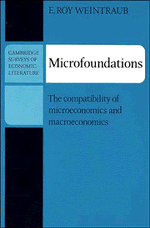3 - The 4,827th reexamination of Keynes' system
Published online by Cambridge University Press: 03 May 2011
Summary
“The price we pay for anticipation of the future is anxiety about it. Foretelling disaster is probably not much fun; Polyanna was much happier than Cassandra. But the Cassandric components of our nature are necessary for survival. The doctrines for regulating the future that they produced are the origins of ethics, magic, science, and legal codes. The benefit of foreseeing catastrophe is the ability to take steps to avoid it, sacrificing short-term for long-term benefits”
[Sagan, 1977, p. 71].Current reinterpretations of the microfoundations of macroeconomics require examination of the structure of the macroeconomic theory that has emerged in the forty-plus years since Keynes “revolutionized” the discipline.
Unfortunately, there is today no accepted view of what it was that Keynes actually accomplished. There is no easy answer to the question of how standard macroeconomic analysis differs from Keynes' own vision. It would seem that we must tackle the problem which has occupied theorists for decades, of identifying the system of Keynes and tracing its transmogrification at the hands of both Keynesians and anti-Keynesians of innumerable persuasions. This herculean task might not, however, untangle current analytic problems.
For better or worse, questions about “what Keynes really meant” stand apart from the creation of rigorous, analytically tractable, and sufficiently rich microfoundations structures. We are interested in studying those “generalized” general equilibrium structures which generate macroeconomic insights. Consequently this chapter will set out various elements of the General Theory in a form which will motivate our discussion in Chapter 4 of the early microfoundations of macroeconomics literature of Hicks, Lange, Klein, and Patinkin.
- Type
- Chapter
- Information
- MicrofoundationsThe Compatibility of Microeconomics and Macroeconomics, pp. 38 - 54Publisher: Cambridge University PressPrint publication year: 1979



